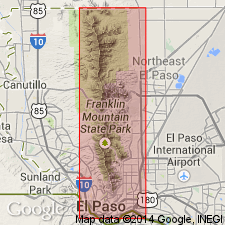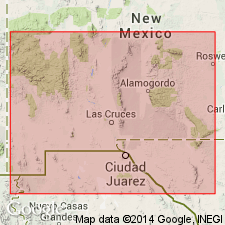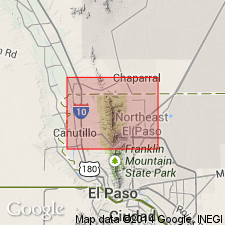
- Usage in publication:
-
- Berino member
- Modifications:
-
- Areal extent
- AAPG geologic province:
-
- Orogrande basin
Summary:
Pg. 89. [Berino member of Magdalena formation.] In Franklin Mountains, western Texas, [Magdalena] formation is divided into (ascending) La Tuna, Berino, and Bishops Caps members (all new). [Age is Middle Pennsylvanian (Strawn).].
See also University of Colorado Bulletin, v. 32, no. 17.
Source: US geologic names lexicon (USGS Bull. 1200, p. 309).

- Usage in publication:
-
- Berino member
- Modifications:
-
- Principal reference
- Biostratigraphic dating
- Dominant lithology:
-
- Limestone
- AAPG geologic province:
-
- Orogrande basin
Summary:
Pg. 167, 168-169. Berino member of Magdalena formation. Predominantly limestone; fossiliferous. Thickness about 555 feet. [Age is Middle Pennsylvanian (Strawn).] Origin of name given.
Named from Berino, on Santa Fe RR about 4 mi north of TX-NM bdry., [Anthony 7.5-min quadrangle], Dona Ana Co., southeastern NM.
[Type locality:] section measured along western flank of Franklin Mountains, opposite Vinton, [Vinton Canyon, approx. Lat. 31 deg. 58 min. 00 sec. N., Long. 106 deg. 31 min. 30 sec. W., Canutillo 7.5-min quadrangle], El Paso Co., western TX (see also Harbour, 1972).
Source: Publication; US geologic names lexicon (USGS Bull. 1200, p. 309).

- Usage in publication:
-
- Berino Member*
- Modifications:
-
- Principal reference
- Biostratigraphic dating
- Adopted
- Dominant lithology:
-
- Shale
- Limestone
- AAPG geologic province:
-
- Orogrande basin
Summary:
Pg. 43-50, pls. Berino Member of Magdalena Formation. Alternating shale and limestone. Thickness 448 feet. Overlies La Tuna Member and underlies Bishop Cap Member, both of Magdalena Formation. Fossils indicate Atokan to Desmoinesian. (Berino Member of Magdalena Formation adopted by the USGS, 1972.)
[Type locality:] in Vinton Canyon, 2 to 3 mi east of Westway on western flank of Franklin Mountains, [approx. Lat. 31 deg. 58 min. 00 sec. N., Long. 106 deg. 31 min. 30 sec. W., Canutillo 7.5-min quadrangle], El Paso Co., western TX (see also Nelson, 1940).
Source: Publication.
- Usage in publication:
-
- Berino Formation
- Modifications:
-
- Revised
Kues, B.S., 2001, The Pennsylvanian System in New Mexico; Overview with suggestions for revisions of stratigraphic nomenclature: New Mexico Bureau of Geology and Mineral Resources, New Mexico Geology, v. 23, no. 4, p. 103-122.
Summary:
Pg. 106-107 (fig. 3, strat. chart), 116. Berino Formation. Previously a formation of Magdalena Group (citing D.V. LeMone, 1982, West Texas Geol. Soc. Pub. no. 82-76, p. 42-72; D.V. LeMone, 1992, West Texas Geol. Soc. Pub. no. 92-92, p. 63-69); [use of Magdalena Group discarded]. Recognized in Franklin Mountains, New Mexico-Texas. Consists of alternating gray cherty limestone and gray shale beds in about a 70:30 ratio. Thickness up to 514 feet (157 m). Age is Middle Pennsylvanian (middle Atokan to middle Desmoinesian).
Source: Publication.
For more information, please contact Nancy Stamm, Geologic Names Committee Secretary.
Asterisk (*) indicates published by U.S. Geological Survey authors.
"No current usage" (†) implies that a name has been abandoned or has fallen into disuse. Former usage and, if known, replacement name given in parentheses ( ).
Slash (/) indicates name conflicts with nomenclatural guidelines (CSN, 1933; ACSN, 1961, 1970; NACSN, 1983, 2005, 2021). May be explained within brackets ([ ]).

